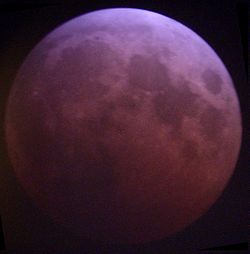| Total Lunar Eclipse 16 May 2003 | |
|---|---|
 From Minneapolis, MN, 3:17 UTC | |
 The moon's path through the Earth's shadow. | |
| Series (and member) | 121 (54 of 82) |
| Gamma | 0.4123 |
| Magnitude | 1.12759 |
| Duration (hr:mn:sc) | |
| Totality | 51:25 |
| Partial | 3:13:53 |
| Penumbral | 5:06:31 |
| Contacts (UTC) | |
| P1 | 1:06:53 |
| U1 | 2:03:11 |
| U2 | 3:14:26 |
| Greatest | 3:40:09 |
| U3 | 4:05:51 |
| U4 | 5:17:05 |
| P4 | 6:13:24 |
 The moon's path across the Earth's shadow near its descending node in Libra. | |
A total lunar eclipse took place on Friday 16 May 2003, the first of two total lunar eclipses in 2003, the other being on 9 November 2003. A shallow total eclipse saw the Moon in relative darkness for 52 minutes and 3.1 seconds. The Moon was 12.938% of its diameter into the Earth's umbral shadow, and should have been significantly darkened. The partial eclipse lasted for 3 hours, 15 minutes and 3.1 seconds in total. Occurring only 0.5 days after perigee (Perigee on Thursday 15 May 2003), the Moon's apparent diameter was 6.2% larger than average. At greatest eclipse the Moon was only 357,693 km (222,260 mi) from the Earth, making it a Super Full Moon.
This lunar eclipse is first of a tetrad, four total lunar eclipses in series. The previous series was in 1985 and 1986, starting with a May 1985 lunar eclipse. The next one was in 2014 and 2015, starting with the 15 April 2014 lunar eclipse.
Visibility
It was completely visible over central Pacific, North America, South America, Atlantic, Europe, Africa and extreme southwestern Asia, seen rising over central Pacific and North America, and setting over Europe and Africa. In South America the entire eclipse was visible lasting just over 5 hours.
Gallery
- Wide Angle view from Minneapolis at 3:35 UTC, near greatest eclipse
Relation to other lunar eclipses
This is the first eclipse this season.
Second eclipse this season: 31 May 2003 Annular Solar Eclipse
Eclipses of 2003
- A total lunar eclipse on 16 May.
- An annular solar eclipse (one limit) on 31 May.
- A total lunar eclipse on 9 November.
- A total solar eclipse on 23 November.
Lunar year series
It is also the second of four lunar year cycles, repeating every 354 days.
| Lunar eclipse series sets from 2002–2005 | ||||||||
|---|---|---|---|---|---|---|---|---|
| Descending node | Ascending node | |||||||
| Saros Photo | Date View | Type Chart | Gamma | Saros Photo | Date View | Type Chart | Gamma | |
| 111 | 2002 May 26 | penumbral | 1.1759 | 116 | 2002 Nov 20 | penumbral | −1.1127 | |
121 | 2003 May 16 | total | 0.4123 | 126 | 2003 Nov 09 | total | −0.4319 | |
131 | 2004 May 04 | total | −0.3132 | 136 | 2004 Oct 28 | total | 0.2846 | |
| 141 | 2005 Apr 24 | penumbral | −1.0885 | 146 | 2005 Oct 17 | partial | 0.9796 | |
| Last set | 2002 Jun 24 | Last set | 2001 Dec 30 | |||||
| Next set | 2006 Mar 14 | Next set | 2006 Sep 07 | |||||
Metonic series
This eclipse is the second of four Metonic cycle lunar eclipses on the same date, 15–16 May, each separated by 19 years.
The Metonic cycle repeats nearly exactly every 19 years and represents a Saros cycle plus one lunar year. Because it occurs on the same calendar date, the Earth's shadow will be in nearly the same location relative to the background stars.
|
|
 |  |
Half-Saros cycle
A lunar eclipse will be preceded and followed by solar eclipses by 9 years and 5.5 days (a half saros).[1] This lunar eclipse is related to two annular solar eclipses of Solar Saros 128.
| 10 May 1994 | 20 May 2012 |
|---|---|
 |  |
See also
References
External links
- Saros cycle 121
- 2003 May 16 chart: Eclipse Predictions by Fred Espenak, NASA/GSFC
- NASA Saros series 121
- Lunar Eclipse Gallery
- Pictures of the May 15-16 Lunar Eclipse
- Prof. Druckmüller's eclipse photography site. Czech Republic


